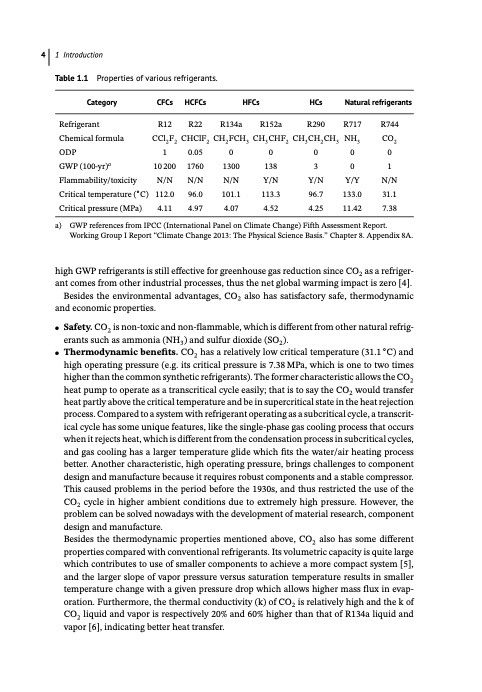
PDF Publication Title:
Text from PDF Page: 020
4 1 Introduction Table 1.1 Properties of various refrigerants. Category Refrigerant Chemical formula ODP GWP (100-yr)a Flammability/toxicity Critical temperature (∘C) Critical pressure (MPa) CFCs HCFCs HFCs HCs R12 R22 R134a R152a R290 CCl2F2 CHClF2 CH2FCH3 CH3CHF2 CH3CH2CH3 Natural refrigerants R717 R744 NH3 CO2 1 0.05 0 0 0 0 0 10 200 1760 1300 138 N/N N/N N/N Y/N 112.0 96.0 101.1 113.3 4.11 4.97 4.07 4.52 3 0 1 Y/N Y/Y N/N 96.7 133.0 31.1 4.25 11.42 7.38 a) GWP references from IPCC (International Panel on Climate Change) Fifth Assessment Report. Working Group I Report “Climate Change 2013: The Physical Science Basis.” Chapter 8. Appendix 8A. high GWP refrigerants is still effective for greenhouse gas reduction since CO2 as a refriger- ant comes from other industrial processes, thus the net global warming impact is zero [4]. Besides the environmental advantages, CO2 also has satisfactory safe, thermodynamic and economic properties. ● Safety. CO2 is non-toxic and non-flammable, which is different from other natural refrig- erants such as ammonia (NH3) and sulfur dioxide (SO2). ● Thermodynamic benefits. CO2 has a relatively low critical temperature (31.1 ∘C) and high operating pressure (e.g. its critical pressure is 7.38 MPa, which is one to two times higher than the common synthetic refrigerants). The former characteristic allows the CO2 heat pump to operate as a transcritical cycle easily; that is to say the CO2 would transfer heat partly above the critical temperature and be in supercritical state in the heat rejection process. Compared to a system with refrigerant operating as a subcritical cycle, a transcrit- ical cycle has some unique features, like the single-phase gas cooling process that occurs when it rejects heat, which is different from the condensation process in subcritical cycles, and gas cooling has a larger temperature glide which fits the water/air heating process better. Another characteristic, high operating pressure, brings challenges to component design and manufacture because it requires robust components and a stable compressor. This caused problems in the period before the 1930s, and thus restricted the use of the CO2 cycle in higher ambient conditions due to extremely high pressure. However, the problem can be solved nowadays with the development of material research, component design and manufacture. Besides the thermodynamic properties mentioned above, CO2 also has some different properties compared with conventional refrigerants. Its volumetric capacity is quite large which contributes to use of smaller components to achieve a more compact system [5], and the larger slope of vapor pressure versus saturation temperature results in smaller temperature change with a given pressure drop which allows higher mass flux in evap- oration. Furthermore, the thermal conductivity (k) of CO2 is relatively high and the k of CO2 liquid and vapor is respectively 20% and 60% higher than that of R134a liquid and vapor [6], indicating better heat transfer.PDF Image | What is a heat pump

PDF Search Title:
What is a heat pumpOriginal File Name Searched:
L-G-0016174002-0052376109.pdfDIY PDF Search: Google It | Yahoo | Bing
CO2 Organic Rankine Cycle Experimenter Platform The supercritical CO2 phase change system is both a heat pump and organic rankine cycle which can be used for those purposes and as a supercritical extractor for advanced subcritical and supercritical extraction technology. Uses include producing nanoparticles, precious metal CO2 extraction, lithium battery recycling, and other applications... More Info
Heat Pumps CO2 ORC Heat Pump System Platform More Info
| CONTACT TEL: 608-238-6001 Email: greg@infinityturbine.com | RSS | AMP |